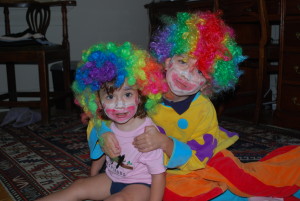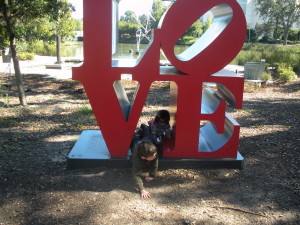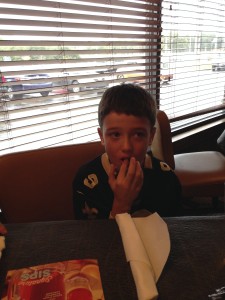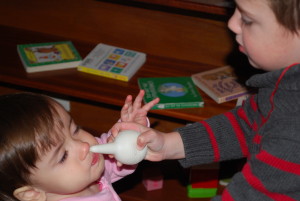Author: lwadams
A Work in Progress
My six-year-old daughter Margot has a problem with what she calls “boy-yee girls.” This chafes me, because my favorite aunt was such a girl. When I was a child, my parents talked about my aunt’s “roommate” accompanying us on beach vacations. Betsy and Jane were two foul-mouthed dames who drank Jack Daniel’s and chain-smoked into the evening, then slept until noon in the same bed. Come on. I made sure my children knew the truth from the start, so they’d consider my aunt’s relationship as normal as mine.
We’re not the most progressive family in the world, but we’re certainly not the least. We live in New Orleans, and our families go back several generations here. The first wedding we attended as a family, though, united two men. Racism, sexism, classism, hetero-centrism, at our house, are past-tense problems. At least that’s how we talk about them with our kids.
But this “boy-yee girl” thing really bothers me, and my daughter can tell. She first used the phrase on a woman I’ll call Cathy, a counselor at camp this summer. I’m sure Cathy noticed Margot giving her a wide berth and a wary stare, but I never got to know her well enough to talk it over. And I guess that’s the point. Aunts Betsy and Jane have passed away, so Margot doesn’t have anyone in her daily life from whom to learn about gender presentation in all its varieties. At best, Margot seems to sense that something’s out of whack. At worst, she seems scared.
Mostly it’s about aesthetics, I think. Margot is a kid who notices things. If there’s a muffin top in a crowd of 200, she’ll point it out. Once, in church, she leaned over and said through clenched teeth, “Mom, there’s a lady in the next pew who’s wearing no shirt.” Actually Margot had a point, because the woman was wearing a strapless top in an Episcopal church, which is almost as questionable.
Margot has had more exposure to differences than I did, so I figure she has a head start on learning tolerance. I have one memory of gender bending from my childhood, and it was Mardi Gras, and he was only dressing up. A girly boy. I was three years old, and that’s prime time for children to learn about gender differences.
I ran out of the bathroom, smack into her. Blue mini skirt, fuzzy knees, red-and-white tube socks, red high heels. Or was it him? I stepped back and looked up higher. Frilly white blouse, blonde braids with red ribbons resting on crooked bosoms. Dirty blonde mustache. As the cigarette smoke hit my nostrils, he smiled and held out his arms for a hug. Red lipstick on his teeth. His wide embrace blocked the way to the kitchen.
Was that Mr. Jack?
What was going on here? Could a man just turn into a lady? What if Dad did that? Would he turn out to be a certain lady like Aunt Shirley? Would he be the mom, then? Wait. Could Mom turn into a man? Or could she turn into something else, like a bear? Would she take care of me then, or hurt me?
“Honey,” my mom reassured me, “we wear costumes at Mardi Gras time. You’re a princess, and Jack’s a lady. I think he might be Dorothy from The Wizard of Oz. You love The Wizard of Oz, right?” In truth, I’d only seen a bit of the movie because I was scared of those flying monkeys in the hats and coats. Cross-species dressing.
My son had a similar reaction to clowns at the same age. Once his panic subsided, he asked me, swallowing, “What are clowns? Are they … birds or something?” It takes awhile to distinguish the irregular from the threatening.
Nowadays Margot’s reaction looks less like fear, and more like distaste. And that’s no better. There’s a tradition in our neighborhood, even though we’re not on the Mardi Gras parade route. On a weekday afternoon a couple of weeks before Mardi Gras, the Jefferson City Buzzards, an all-male walking parade dating back to 1890, struts around our neighborhood dressed as women. My husband used to be a member. It’s roughly fifty men, exuberant after a liquid lunch. Last year, when Margot was five, a man in a black leather-and-lace teddy and thigh-high leather boots shimmied up to her and handed her a string of pink Mardi Gras beads. She took the beads and smiled, then backed away. Was she scared?
“Mom, that man has a pretty outfit but he’s too hairy for it.”
He offended her aesthetic sense, is what happened. She reminded me of my mother when she first saw a man in skinny jeans.
But that wasn’t the end of it. This summer at camp, Margot met Cathy, who was entrusted with the job of head counselor. She was also the woodworking counselor, wielding the sort of tools that impressed both my children.
At first glance, Cathy looked male. The first sign she was female was her name. Her hair was shaved on the sides, she wore roomy cargo shorts and tee shirts, and her ears were pierced in a manner that’s so uncommon in my circles I finally had to break down and research it online. It’s called “stretching,” which means that her earlobes were pierced in the conventional way, and then gradually stretched to accommodate an earring about the size of a washer. It creates a hole big enough to look through.
Despite our superficial differences, I immediately identified Cathy as my kind of person. Each time she had to discipline my impulsive son she did so by touching him, and speaking in a voice only he could hear. She never involved me. James listened to Cathy, even said she was his favorite counselor.
I asked Margot about Cathy and she said, “Cathy’s okay, I just don’t like her.”
“Does it have something to do with how Cathy looks?” I asked, and Margot bristled. She knew she was setting herself up for a lecture.
“No, Mommy, it doesn’t. I know girls can be boy-yee and boys can be girly. They’re born that way. Okay?” So something had sunk in.
If the stretched earlobes were what disturbed Margot, that was cool with me. The whole stretching process, although safe, seems painful and much too permanent for my taste.
If Margot disliked Cathy for being a boyish-looking girl, that was going to be harder to take.
“Is it her earrings?” I asked.
“Maybe,” said Margot. My hopes surged.
“Well, how about we ask her how it’s done and if it hurts?” I replied, using my usual strategy of information-gathering to fight a fear.
“No,” said Margot. “But can we ask her what kind of underwear she wears?”
In other words, she wanted to know how deep this boy-yee thing went.
It was fine with me that Margot was curious. What bothered me was her behavior. Margot avoided Cathy all week, so she never got to know her like my son did. While James sat next to Cathy at the campfire, hollering obnoxious camp songs, Margot brooded on the fringes. All because of the way Cathy looked.
It feels like I’ve failed both Margot and Cathy.
The culture has changed between my childhood and Margot’s, but brain development hasn’t. Children still learn about all types of differences over time. So maybe I’m the one who needs to relax.
I hope Cathy’s back next summer, and that Margot can have another chance.
Author’s note: It’s only been five months since summer camp, so I can’t say we’ve made any progress. That’s okay, though. In the transition from child psychologist to mother, I’m getting used to being more patient than I ever thought I’d have to be.
Lynn Adams lives in New Orleans with her husband and two children. A former child psychologist, she now writes parenting essays about child development and Autism Spectrum Disorders. Her work has appeared in Brain, Child; Salon; Scary Mommy; and other places in print and online. Find more of her work at www.lynnadamsphd.com.
How I Wimped Out With My Autistic Child
Cold Inside
Before I had children, Autism Spectrum Disorders were my specialty. I reduced my child psychology practice to half time after James came along, and soon realized I couldn’t close the door on autism at the end of the workday, because it was in my house.
I first heard about autism in high school, at a children’s residential facility where I volunteered. Sam was lying on his back and spinning around in circles by kicking his feet, as if on an invisible merry-go-round. He wasn’t brushing his teeth alongside the other children, because he was having too much fun at his own carnival.
I determined to become part of Sam’s carnival, and eventually learned to play with kids whose parents thought they couldn’t play. So 20 years later, why did I find myself on our playroom floor, my back against the sofa, writing down everything James said, while he did his own thing? “You sit on that. You like that. You put it down there,” I transcribed, noting he had his pronouns reversed. I hope I took the time to talk to James as I wrote, but I don’t remember.
My son was a loner. It didn’t come naturally to him to connect with anyone, including – and maybe especially – me. Instead of crying or looking for help in a tough situation, James mounted a noisy protest. Every tantrum was a puzzle. When he started talking, my first sign that he’d hurt himself was hearing him screech, “No ice!” as he ran away from me. If I figured out he had a pebble in his shoe, captured him, and removed it, he calmed down immediately.
By contrast, every time I kissed James’ cheek, he would rub the spot with his hand, looking away, like a teenager. He was unaffectionate. He had sensory issues. Of course. He had autism.
I knew that underlying health issues could be a source of toddlers’ developmental and behavioral problems. So, I arranged a medical evaluation for various thyroid, allergy, immune, and metabolic problems that might have been an easy fix. And the doctor found something. We discovered that one of James’ vaccines hadn’t been effective, exposing him to frequent upper respiratory infections. And all that time I thought he had allergies. He got a booster shot and the colds went away, but the autism didn’t.
That’s right, I’m the mom who thought that a vaccine might cure her child’s autism.
Practically speaking, as part of these work-ups three-year-old James had to have his blood drawn three times in three weeks. Although James freaked out the first time, the second and third times he patiently held out his little arm as the nurse poked around for his tiny veins. She kept looking up at his face, waiting for him to blow his stack. He never did.
The nurse remarked, “This is the best-behaved child I’ve ever seen!” Then she gave him a jumbo pack of Starburst and a full roll of stickers.
Her compliment felt like an accusation. I was still out of breath from forcefully extracting James from under the Lego table in the waiting room, where he’d been holed up catlike for a half hour. Before that, I’d pried him out from under the car seat, and then carried his noodle-like body through the parking lot. Back at home, he’d resisted brushing his teeth, getting into his clothes, leaving the house, and getting into the car. The whole way out to the suburban office he’d looked out the window, exclaiming with joy anytime he saw a construction truck. But each time a truck disappeared from his view, he’d kick the back of my seat.
James was a good boy, just not for me.
As my office became a refuge and I accepted a patient who would eventually become James’ first friend, I began to wonder whether I was ever meant to be a mother. One evening, my infant daughter asleep on my shoulder and a glass of gin in my hand, I made a suggestion to my husband Bruce. Maybe I was better off, and James was better off, and the community would be better off, with me as a psychologist rather than as a mother.
A parent-ectomy. That’s what Bruno Bettelheim proposed in his 1967 book, The Empty Fortress, a book my parents might have read if I’d had autism. Early professionals observed that mothers whose children had autism were cold and distant: Refrigerator Mothers. But sometimes it feels better to focus on doing right by your child, than to interact with him. Contemporary studies refer to “parental stress” and investigate the effects of having a child with autism on the parents.
Instead of condemning me for my cold-hearted suggestion, Bruce appealed to my sense of reason. “Think of your favorite families you’ve worked with, your favorite adults with autism,” he suggested. “What did they all have in common? Good psychologists, or good parents?”
Kids in our town had some choices when it came to psychologists. But James had only one mother.
Around this time, I came across a newspaper article. Researchers at the Yale Child Study Center, my old stomping ground, found that administering oxytocin, “the love hormone,” led to activation in the brain’s social regions in a small sample with mild autism. I wondered where I could get some oxytocin for James, and then flagellated myself for wondering.
James needed a mother’s love, and I was giving him everything but that.
I stopped reading about autism, and started reading about motherhood. I especially liked Erma Bombeck, who wrote, “A child needs your love most when he deserves it least.” At first I took my fondness for this quote as further evidence that I’d become a refrigerator mother, but later I realized how many kids it’s kept alive.
So James didn’t know how to connect with people. I did. It was time to show him how.
Neglecting to tell Bruce where I’d learned it, I pulled out the trusty “basket hold,” a form of restraint I’d used during my internship in a children’s psychiatric hospital. It was the only way to get ahold of James. You grab the child’s wrists, cross them in front of him, and pin his body in your lap with your legs crossed over his legs and his head under your chin. It’s a hug you can’t refuse.
As I held James I would say things like, “I know you’re mad because your toy broke. No biting, though. That hurts me. You’re my boy. Mommy loves you no matter what.”
I was talking to myself, more than James.
Over time, I didn’t have to hold James so tight to keep him near me. When he was really upset, he’d often give up his struggles and sob on my shoulder. Then I really felt like his mother.
One day after a basket hold I kissed James wetly on the cheek, and he immediately wiped it off. I decided to ask him about it. How did I know why he did it?
“Did you wipe that kiss off?”
“No,” James said, still rubbing.
“Well, what are you doing?” I asked.
“Rubbing it in. That way it makes you love me more.”
Now at this point, James had his pronouns reversed. So, he probably meant, “It makes me love youmore.” But who cares what direction he was heading? The fact that the word “love” was in his vocabulary suggested I was on the right track.
Author’s Note: James still struggles with the stresses of everyday life, and our family struggles along with him. But I don’t dwell on the word “autism” as much as I did when I started writing this piece. Instead, I focus on James’ love of guitar and flag football, and on his strong relationships with his family, neighbors, teachers, and friends. I’m proud to say he’s the only member of our family who’s consistently described as “sweet.”
Bio: Lynn Adams is now a full-time wife and mother in New Orleans. Her work has appeared on Salon, Brain, Child, and The Mid, as well as in the anthology, It’s Really 10 Months: Special Delivery. Find more at www.lynnadamsphd.com.
10 Tips for Extremely Picky Eaters
Desperate To Get Nutrients Into Your Kids? Become Their Snack Servant
10 Reasons My Son Won’t Eat His Dinner. An Exercise in Futility?
Dr. Mom
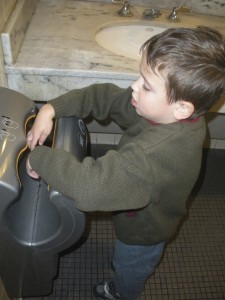
Lynn W. Adams, Ph.D
When my son James was between the ages of two and four, he had a big problem with hand dryers. In most public restrooms the instructions read: 1) Press button, 2) Place hands under nozzle, 3) Rub hands briskly together. Occasionally, some wise guy has added: 4) Wipe hands on pants. James’ responses to hand dryers included: high-decibel screams, pants-wetting, crawling under stall doors, and wedging himself into the backseat like a molly screw. The apex of our hand dryer horrors took place in a roadside McDonald’s the summer James was four. We were returning to New Orleans from a hand-dryer-heavy trip to North Carolina and James was squirming around the booth after picking at his hamburger bun, his little thighs going squeak- squeak on the yellow molded plastic.Instead of gullibly asking if he had to pee-pee, I just said,“Honey, let’s go use the potty.” Our family of four crept toward the promisingly labeled Family Restroom, James clinging catlike to any obstacle in our path.
The closer we got, the louder he shouted. “No, I don’t have to
go! Please, please don’t make me go in there! No hand dryer! I really don’t have to go!” I smiled apologetically at a woman as I peeled his hand off of her purse strap, but she didn’t smile back.
Five minutes later, when we emerged disheveled and unrelieved from the restroom, James now desperately grabbing his crotch, my husband suggested we beat a hasty retreat in case someone had called the authorities. Indeed, all eyes were on us. We dumped our fries and split.
Before I was James’ mother, I worked as a child psychologist. I wanted to ease his suffering at the McDonald’s, but I was also embarrassed that I couldn’t manage my kid. At first, I had tried that old bachelor’s-level technique, avoidance. I avoided public restroom changing tables by performing clandestine diaper changes in the car seat , in the hatchback, behind a bush, and in the stroller. We got by until James was toilet trained. This new accomplishment came with, in addition to Bob the Builder underwear, a need to use public restrooms. There’s only so much pee-peeing in a bush that polite society can tolerate. When I think I’m having a hard time handling things, I just remember the day I helped one child poop very tidily in a bush with the other one strapped to my back. Twice.
This became my public restroom survival kit: a clutch of paper towels, a few blank post-it notes, and some post-it notes that read: “HAND DRYER OUT OF ORDER. PLEASE DO NOT USE.” Our routine went like this: 1) Enter restroom warily; 2) Post out-of-order signs on any and all hand dryers; 3) Place a post-it over the sensor for the automatic flush; 4) Take care of business; 5) Wipe hands on paper towels and collect supplies; 6) Move on. It worked well, but like most irrational fears, this one mushroomed each time we avoided it. At first, it was okay if we didn’t use the hand dryer. Next, no one in the restroom could use it. Eventually, going to a place that might have a hand dryer became too much to bear. I found myself living the pages of my Abnormal Psychology textbook.
A large portion of my psychological training came from proponents of Cognitive-Behavioral Therapy (CBT), a very tidy approach to problem-solving. You identify a problem and perhaps any mistaken assumption associated with it, and then change either what comes before (triggers) or what comes after (rewards or punishments). I first used CBT to train my cat, Walter, to use his scratching post. Instead of whacking him for scratching the sofa, I put a container of treats on top of his post and gave him one every time he scratched it. It was humane and effective. My textbook made the point that a mollusk could be trained to clap its shell on command. Wow, I thought at the time. What can’t CBT do?
Oblivious, I hunkered down. In an attempt to render the scary hand dryer more friendly, we studied up. We printed out pictures of various hand dryer models and posted them around the house. My sweet husband made several hand dryers from boxes, and mounted them in our bathrooms. I came to expect James’ soft, earnest “vvvvvvvvv” sound effect after the flush and the splashing. In Psychology Land, we call this Systematic Desensitization: exposing the child to closer and closer approximations of the feared object to build up tolerance. I stopped short of planting him under the hand dryer in my office building with a pile of M&Ms, but I kept up the campaign from August to November.
One would think that four months of earnest intervention from a psychologist / mother would suffice. When it ended, though, the success was clearly James’ alone. One day, James had to go to the hospital for a medical test. On the way there in the car, we talked about his reward. I had some suggestions: ice cream, a smoothie, the playground, the vacuum cleaner aisle at Lowe’s, the guitar store, a nearby construction site. James looked out the window for such a long time that I’d given up hope of an answer.
As we pulled into a parking space he said, still looking out the window,“No, Mommy, I think I’d like to go to the grocery store and use the hand dryer.”
About the Author: Lynn Adams lives in New Orleans with her husband, son, and daughter. After studying at the Yale Child Study Center and the University of North Carolina at Chapel Hill TEACCH program, she worked as a child psychologist specializing in Autism Spectrum Disorders. Being part-time psychologist, part-time homemaker seemed like the best of both worlds. It wasn’t, and now she is a full-time mom. She is a co-author of Autism: Understanding the Disorder and Understanding Asperger Syndrome and High Functioning Autism.
The Outsider: On Siblings and Autism
My children have shut me out of their closed relationship, and that’s a wonderful thing.
It began during a friend’s visit, in the playroom with my newborn daughter and two-year-old son. The friend had brought a blanket for Margot and a red pinwheel for James. James wasn’t able to blow yet, and I was concerned about it, and later I’d see it as an early sign of his Autism Spectrum Disorder. So he couldn’t work the pinwheel, even after we showed him. Dread was a familiar feeling by then.
My friend and I talked about the baby. Her delicate size, her tendency to sleep angelically all day and cry all evening, her mop of hair the same color as James’. I looked over at James just in time to see him inspecting the sharp end of the pinwheel’s stick. His gaze next moved to his baby sister’s fuzzy head, then back to the pinwheel. He reached out with the pinwheel and poked her. Their eyes locked, but what passed between them surprised me: a combination of thrill and interest as if they’d each just opened a surprise birthday gift and found the other inside.
This is it, I thought: the beginning of the older brother menacing the younger sister. I’d known it was coming, as that’s what I’d experienced with my own brother, four years older. My brother, now a perfectly respectable father of two, had dipped my face into a creek like a chicken nugget into mustard sauce. He’d given me “noogies” well into his thirties. He’d lure me into his room, turn off the light and close the door, and murmur, “When you least expected it… expect it.”
That evening, when I announced bath time, James shouted, “You can’t hear! Baby cry!” He reversed his pronouns, “I” for “you” and “you” for “I,” another early sign of autism that stoked my dread. But he was also using his new sister as a smokescreen. Could they be working as a team? Could James even do that if he had autism?
There are as many ways of having autism as there are people who have it, and James did eventually receive the diagnosis. Since before Margot’s birth, he had been attending developmental therapies to address his delays, and appointments with specialists to rule out other problems. His main challenges during those early years were language development, and ,relatedly, big-time tantrums. We also had to work hard to connect with him socially, to bring him out of his own head and into the world around him. Through the appointments and the tantrums, Margot tagged along.
At one year of age, Margot started each day by standing up in her crib and yelling, “Jay! Jay Jay!”
He’d hop in with her and they’d roughhouse for awhile.
One morning I heard James saying, “That’s right, Margot. Just pick up a leg and put it right there. Now pull with your arms. I’ll catch you, don’t be scared.” He was mimicking Ms. Sharon, his occupational therapist, almost word for word.
Bump! Margot hit the floor and they both exploded in giggles. From then on, Margot was out of her crib like a super ball every morning before 6:00, bouncing into James’ room.
The next year, James took Margot’s hand, led her into the bathroom, and closed the door. “Just a minute, Mommy,” he said over his shoulder. “I’m going to teach Margot how to use the potty.”
She was his little doll. Everything that was done to him, the instruction, the encouragement, he did to her.
Soon the shenanigans began. One would distract me with a lost toy or a spill, and the other would get into the forbidden fruit, whatever it was that day: my makeup, the toilet bowl, the cookie jar, the trashcan.
“I can’t bear it,” I said to my mother. “They’re the dynamic duo, working together to spread mayhem. How did you handle it when we were little?”
She paused, then said, “It was different with you two. Mostly your brother just menaced you and you tattled on him. Other than that, you didn’t interact all that much.”
Interaction. One of the main areas of impairment in autism, that’s what James and Margot did all day long. Starting with the curiosity of the pinwheel poke, moving through the brother-to-sister lessons on climbing out of the crib and using the potty, culminating now in the give-and-take of the hi-jinks, James and Margot already had a closer relationship than I’d had with my own brother. And neither of us had had autism. What was next? Empathy, that holy grail of social skills development?
Now, let me be clear. Close relationships are not always harmonious ones. James and Margot do their share of fighting, physically and otherwise. They’ve left longlasting marks on one another’s bodies that other people have noticed. But no scars. I continue to complain to my mother about the fisticuffs, the potty words at the table, the madcap dashing around the house.
I’d worried that Margot would have to take care of James, that she’d visit him in the group home, her kitten heels clack-clacking on the linoleum. And that was because of James’ autism. Even before he was diagnosed, though, I worried I’d have to protect her from the menace of her older brother. Like many a worry, these were misplaced.
One day last year after school, Margot got out of the car, sat down cross-legged on the sidewalk, and refused to move. We’d parked a few houses down from ours, so James and I set off down the block, figuring she’d get up and follow. Instead, she began to scream, “Mommy! Don’t leave me here! Don’t leave me all alone! Mommy!”
The girl just needed to get up and walk into our house. But she wasn’t going to go quietly. This had all started when I told Margot she couldn’t have a stick of gum. Of course, that wasn’t the whole story. It had been a long day. But she wasn’t the one with autism. Why couldn’t she just do as she was told?
How did I handle it? I didn’t. Because before I could get over my internal argument about comforting my distressed child versus giving in to a brat, James came to Margot’s rescue. He walked back down the block, hoisted her up, and carried her home, her little legs flapping against his shins. She rested her cheek on his shoulder and closed her eyes. He put her down on the front steps and kissed her.
“Thanks, James,” I said.
He kissed her again, not even seeming to hear me.
Reading All the Parenting Books Just Made me Feel Like a Failure
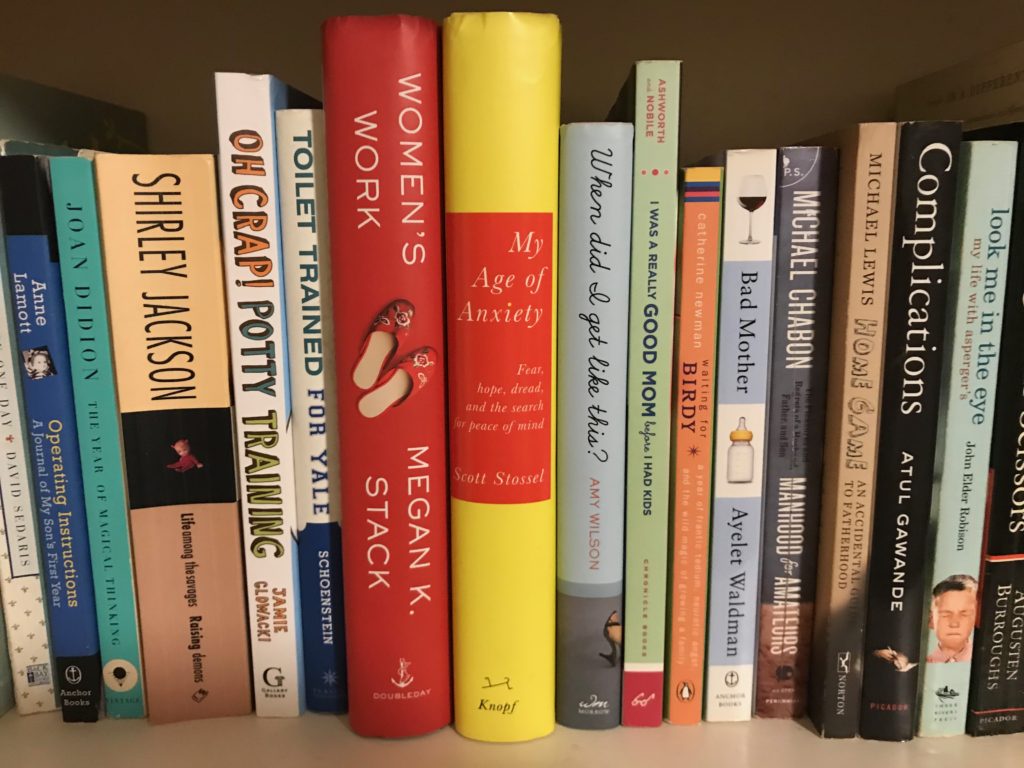
Early parenthood is hard. Instead of needing to solve every problem, how about just coping?
I’ve always been uptight, and it just got worse when I had kids. So I’ve been working on it, starting with Mardi Gras. One stifling Lenten morning by the sandpit, a woman hiked up her maternity shorts and said, “You can either have a tidy house or happy, healthy children.”
I felt a surge of love for her. People said things like that when my first child was a newborn, but I wrote them all off as slackers.
“Yes, indeed,” I said. “At our house the Mardi Gras bead situation is out of control, and I just turn my head and look the other way.” I learned this from a friend whose husband leaves the Christmas tree up until Easter.
A wispy-haired dad busted in, “You know, you have to watch those Mardi Gras beads because they’re from China. A lot of things from China have lead in them.” He patted his son’s wispy hair.
What is with these buzzkillers? First they try to peddle me the nonsense that is “nipple confusion,” and now they’re trying to take away my kids’ Mardi Gras?
My kids had spent the previous Fat Tuesday up in a ladder together, both with drawn-on mustaches but one dressed as U2’s The Edge and the other as a ballerina. That year, Margot woke us up on Mardi Gras day by hollering from her crib, “Hey, Mister! Throw me something!” Our kids were a couple of maniacs, and thank goodness because that’s a pre-requisite for being a native New Orleanian. Now I was supposed to worry about poisoning them by letting them play with beads their customary three months after the holiday? They were standing in cardboard boxes and throwing them over the side, not eating them.
By sandpit day the kids were two and four, and I’d learned how to ignore buzzkillers. I had every right to complain about them, too, having been one myself.
Breastfeeding was my first buzz-kill. There are tons of books on the subject, and tons of time to read while doing it.
When James was a week old, the grandfatherly head of the pediatric practice called one morning just to check in. I could hardly hear him over the screams. “Have you tried a pacifier?” he enunciated.
“Oh, no,” I shouted. “I’m breastfeeding.”
“So?” he roared.
“So, I don’t want him to get nipple confusion,” I said shrilly. The books said not to offer a pacifier or any nipple other than my own for the baby’s first two weeks. Otherwise, the child could possibly prefer the inferior nipple substitute and the whole thing was doomed.
There was a faint thumping and a muffled moan. “In my 40 years of practice, I have yet to encounter a single case of this ‘nipple confusion’ of which you speak. Now, while I’m on the phone, I want you to get a pacifier and put it in that baby’s mouth.”
I wish I could say it was smooth sailing from there, but it wasn’t. For me, it was natural to continue in early motherhood doing what I’d always done, which was looking for answers in books. For James, it was natural to scream the house down.
After James and I mastered breastfeeding, I read about screaming. There were lots of reasonable techniques in The Happiest Baby on the Block that helped a tiny bit with James, and later a lot with Margot (another screamer). I had high hopes for a book called Secrets of the Baby Whisperer, and read it like the Bible. It told me how, from the very beginning, I could “start as I meant to go on.” I could establish a routine during James’ first days and use that routine to increase sleep periods and decrease fussiness: Eat, Activity, Sleep, then Time for You. The acronym was EASY, but my baby wasn’t easy.
When the baby-care books failed, or, more precisely, made me feel like I’d failed, I went straight to the experts. We visited two pediatric gastroenterologists. The first advised me to go on a starvation diet, and later to stop breastfeeding and start soy formula. The second said that was a bunch of bunk and prescribed an antacid for James. He also said that it was possible I just had one of those fussy babies.
After living through nine months of fussiness with James, I came to a conclusion. Being a baby is uncomfortable, some babies are more sensitive to this than others, and some babies are harder to soothe than others.
I didn’t need a book to learn that time was the solution, and the choice was not what to do, but how to cope while waiting for the problem to vanish, or at least morph into another problem.
A mantra, perhaps, “Suck It Up,” would have done the job. Or, better yet, a mental image.
In the 70’s there was a soap commercial with the tagline, “Calgon, take me away!” The heroine was an embattled homemaker who relaxes in a frothy bubble bath and floats up into the clouds in a bubble tinged with pink.
In my version, it’s a gleaming white clawfoot tub and my skin is dewy because of both the bubbles and my serenity. As my bubble rises toward the playroom ceiling, I extend a soapy arm over the side of the tub. I gaze down at the children.
Below me, James is lying on his back, clutching a posterboard guitar that is ripped in two, yelling, “Right now, right now, right now you have to put it back together!” He spins clockwise, powered by his stiff little legs.
Just a few feet away, Margot is an island in a puddle of pee, looking down at her shoes quizzically. She looks up and says, “Oh, Mommy, look what happened.”
The doorbell and the phone ring at the same time.
I hear only the wet smack of the popping bubbles, smell only their lavender perfume. My skin is warm. How it glows.
I can only describe this feeling as a buzz.
